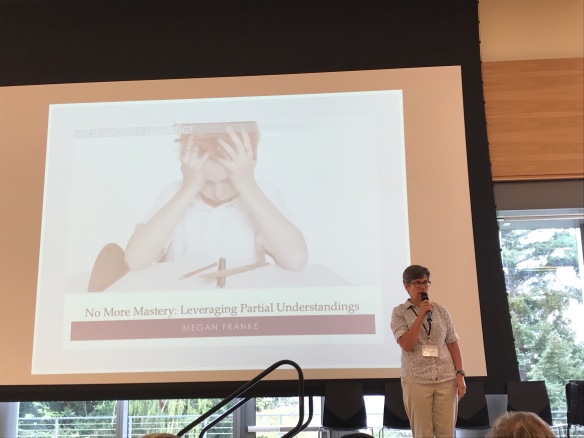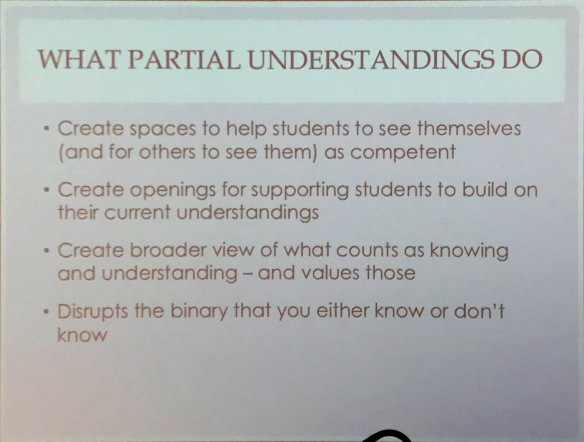This blog post was co-written with Rachel Lambert and available on both blogs.

A couple of years ago, Rachel Lambert and myself were talking about how students in special education are conceptualized. We were sick of hearing about the “gaps” and the “holes” in our student’s learning. One of us, (probably Rachel!), blurted out – “Our students are not Swiss cheese!” We laughed, since this summed up for us how learners with disabilities are both over-analyzed and under-educated, always seen as the sum of their deficits, not their strengths. What follows are two recent experiences we’ve each had in which the idea of thinking of students as Swiss cheese has resurfaced.
Rachel’s Story
During a professional development session recently in southern California, I asked the gathered special education teachers to describe their questions in working with students with disabilities in math. Many of their answers referenced “holes” and “gaps.” They were concerned about what their students did not know. Yet this thoughtful group of educators also shared puzzling contradictions about what their students did know. One teacher described how her student with a significant disability, who was not able to reliably recognize numerals, was able to do addition when presented with a CGI story problem and manipulatives. Another noted that she had a child who had difficulty with addition and subtraction under 20, but could do multiplication with multi-digit addends. Are these gaps? Holes? Or do these kids, with a unexpected patterns of development, actually help us question the tired metaphors of knowledge that we use in education?
What do I mean by that? This metaphor of “holes” and “gaps” presupposes that real mathematical knowledge is a filled-in, completely solid progression. These two students are not playing along with this metaphor; they know more advanced topics first and struggle with the more basic ones. And they are not alone. I have met many students with disabilities who learn topics in a turned-around order, who challenge typical linear learning trajectories. I also know many “typical” learners with plenty of “holes” and “gaps.” Maybe it is not the learners; maybe it is the way that we conceptualize learning…
One phrase used to name these student’s unique learning trajectories was “splinter skills.” This is a phrase often used in relationship with autism, and tends to suggest that even when a person with autism knows some higher-level content, such as advanced mathematics, because that person has other challenges (usually with lower level content), those skills are “splinter,” unconnected, unimportant. Attention should be paid to what the person cannot do- otherwise how will we fix them?
Are there other metaphors for learning, not so filled in, not so linear? I prefer “landscape of learning,” used by Maxine Green (1978) (pioneer in arts education), and in mathematics education, by Cathy Fosnot and Martin Dolk in their series, Young Mathematicians at Work (2002). In this way of thinking, there are multiple paths to mathematical understanding. In this image, I have reconstructed a landscape of learning multiplication with a group of teachers:

This also makes sense in my (Rachel’s) experience teaching students, both with and without disabilities. Students learning multiplication sometimes rely on skip-counting, some-times repeated addition, sometimes move easily between the two. Learning is complex, multi-leveled, and no one is all the way “filled in.” I asked participants at the workshop to think about themselves as learners—are they are the way filled in? I know that I am not. I am constantly learning, and it is not like filling in a coloring book. Instead, one thing I know leads to another, to another, like paths in a landscape.
If a child is having difficulty with multiplication, and we assess them, we might find that they typically use skip counting, and not repeated addition. Do we address the gap, teaching them repeated addition? Or do we build on what they know, skip-counting, to move them towards the real goal: conceptual understanding and procedural fluency with multiplication?
When we conceptualize learning as linear, students with disabilities, who tend to learn “differently,” will be conceptualized as incomplete. When we conceptualize learning as a process, as having multiple paths, we can understand all learners as in movement, as in process. We can focus on guiding them along their path, rather than remediating. After all, our kids are not swiss cheese!
Andrew’s Story
This summer I spoke at the Cognitively Guided Instruction conference held at the University of Washington. During the conference, Megan Franke, co-author of the CGI series of books, gave a pertinent talk titled, “No More Mastery, Leveraging Partial Understanding.” Here is the description of the talk from the CGI Seattle program:
How do we notice and use what students DO know to support them to make progress in their thinking? Partial understandings provide great opportunities. This session will focus on seeing how we can use partial understandings to support students’ mathematical learning and thus challenges our common notions of mastery.
 Franke spoke about how teachers can not only uncover individual student understanding by focusing on “partial understanding,” but they can also leverage this understanding in a strengths-based method to push students further, and not to remediate their deficits.
Franke spoke about how teachers can not only uncover individual student understanding by focusing on “partial understanding,” but they can also leverage this understanding in a strengths-based method to push students further, and not to remediate their deficits.

Franke ended her talk by revealing she was not happy with the term “partial understanding” because it inherently carries deficit connotations. She asked that we try to conceptualize a different term; one which could bring the positive strengths-based allusions she was hoping for teachers to utilize. The NCTM publication, The Impact of Identity in K-8 Mathematics: Rethinking Equity Based Practices offers another view of Franke’s “partial understanding.” The authors suggest “leveraging multiple mathematical competencies” as way to structure student collaboration so that student strengths are maximized and this desire to “fill gaps” is minimized. Students are strategically grouped in ways that allow students to learn from each other and push each other forward in their learning. Utilizing this viewpoint, I believe teachers do not need to fill gaps or holes, because all students are able to contribute their mathematical competence to the community of learners.

Takeaways:
- Let’s move beyond tired metaphors of learning that assume that learning is linear and predictable, towards a landscape of learning
- These overused metaphors of “gaps” lead to conceptions of students as “swiss cheese”
- Instead, let’s build on what students know, which always provides a path forward
- And help students see that in when they collaborate in groups they can leverage multiple mathematical competencies.

Let’s also remember, though, that “gaps” is language that already is an improvement over a strictly linear interpretation.
I agree that there’s a huge problem with regarding math as a mess of discrete skills that we need to patch up with some kind of filler.
LikeLike
Pingback: Decimals, Backwards Slashes, and Giggling in Math Class | mathontheedge
Thank you Andrew and Rachel for these important thoughts. Just as in a conversation different points of view provide a richness to everyone’s understanding, students’ different ways of thinking and approaching a topic can provide a richness to the entire class and to our own understanding. Lets not force everyone to the same path and view of mathematics. Lets listen, and learn to value and build from the strengths that each child brings.
LikeLike
Pingback: Models of Disability | The Learning Kaleidoscope